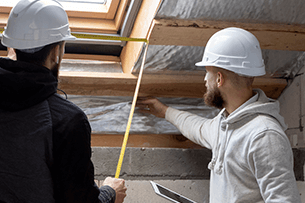How To Deice Your Roof
What are ice dams and how are they formed?
How will that affect my roof?
How do I de-ice my roof?
- Snow rakes: A snow rake, also known as a roof rake, is a shovel designed to scrape snow off your roof manually. If you’re willing to, you can step out with caution to scrape off the snow and icy crusts after a big snowfall. It is a physically intensive process that may need to be done repeatedly throughout the snowfall so as to not let the snow accumulate.
- Ice picks: The age-old method of de-icing a roof is to use an ice pick. It is also a pretty labor-intensive process and should only be done after taking safety measures. Make sure you place your ladder against a solid surface like a wall. Have another person assist you to make sure your ladder stays stable. Wear your safety goggles and using a gloved hand, reach into the gutters where the ice dam has built up and use moderate force to pick the ice. After patiently chipping, some pieces eventually split, crack, and fall away. Ice picks are incredibly sharp and can damage your roof if you’re not careful.
- Ice melter liquids: Ice melter liquids or de-icing chemicals work wonders to melt off the ice dams. A quick trip to the hardware store and you will find the products you need. However, it is important to be aware of the components in these chemical liquid deicers to avoid damaging your roof. Though low-investment-high-returns products are very tempting, they are damaging and corrosive to the roof as well as the environment. They should not be used on your roof. Invest in a good chemical deicer to ensure the long-term health of your roof and roof system. Avoid liquid deicers with Sodium Chloride and Calcium Chloride in their compositions. Based on need, you can invest in rocky deicers, or finer powdery deicers, or liquid deicers. Basswood Roofing provides services ranging from ice dam removal to ice melter for driveway to roof snow removal services and winter roof repair.
- DIY de-icers: Popular on the internet, DIY deicers using various components commonly found at home are thrown together and sprayed on the roof, in hopes of melting the ice dams away. Tempting as they may be, DIY deicers tend to yield short-term relief and long-term damage to the roof, unless you are aware of the composition of the products used and know what is to be done. Do not try DIY deicers before doing some research about suitable elements for your roof type.
CONTACT BASSWOOD:

How Often Should You Replace Your Roof?
Roof, despite being an integral part of our home is often overlooked when it comes to cleaning and maintenance. A lot of homeowners usually don't take notice of their roof condition unless it begins to leak or disintegrate.

Roofing Maintenance 101: Caring for Different Types of Roofing Systems
There are various kinds of roofing systems each with their specific maintenance requirements. Here are some crucial maintenance procedures to follow that will help you lead a carefree life at your home.

Winter Roofing Checklist: Getting Your Roof Ready for the Cold
Winter is a time where roofs need our special attention and preparation to protect our homes from harsh weather and windy breeze. One of the most crucial things you can do for your family and house is to prepare your roof for winter.

Insulation Sheets 101: Understanding Their Types and Benefits
Insulation sheets, also known as insulation boards or foam boards, are materials used to reduce the transfer of heat, sound, or electrical energy between surfaces.

LP Smartside Siding Vs Vinyl Siding: Which is Right for Your Home?
Making the right choice when it comes to your home’s siding is vital as it has a massive impact on both its aesthetics and functionality. There are several options when it comes to sidings for your home.

The Importance of Winterizing Your Roof: A Comprehensive Guide
In this comprehensive guide, we'll explore why winterizing your roof is essential and provide practical tips to ensure your home is well-prepared for the colder months.

What are the different types of Gutter Guards: Pros and Cons
Imagine an armory of defense for your gutters; that is essentially what a gutter guard is! It's a gutter guard protection that protects your gutters from debris and blockage.

How to protect your Roof from Storm Damage
The roof of your home is the first line of defense against the elements, especially during storms. Storms can wreak havoc on roofs, causing costly repairs from high winds to heavy rain and hail. Protecting your roof includes more than just reacting to storms
SERVICE AREAS
List of Services
-
Beloit, WI Write a description for this list item and include information that will interest site visitors. For example, you may want to describe a team member's experience, what makes a product special, or a unique service that you offer.
Item Link List Item 1 -
Clinton, WI Write a description for this list item and include information that will interest site visitors. For example, you may want to describe a team member's experience, what makes a product special, or a unique service that you offer.
Item Link List Item 2 -
Evansville, WI Write a description for this list item and include information that will interest site visitors. For example, you may want to describe a team member's experience, what makes a product special, or a unique service that you offer.
Item Link List Item 3 -
Fontana, WI Write a description for this list item and include information that will interest site visitors. For example, you may want to describe a team member's experience, what makes a product special, or a unique service that you offer.
Item Link List Item 4 -
Janesville, WI Write a description for this list item and include information that will interest site visitors. For example, you may want to describe a team member's experience, what makes a product special, or a unique service that you offer.
Item Link -
Lake Geneva, WI Write a description for this list item and include information that will interest site visitors. For example, you may want to describe a team member's experience, what makes a product special, or a unique service that you offer.
Item Link -
Orfordville, WI Write a description for this list item and include information that will interest site visitors. For example, you may want to describe a team member's experience, what makes a product special, or a unique service that you offer.
Item Link -
Walworth, WI Write a description for this list item and include information that will interest site visitors. For example, you may want to describe a team member's experience, what makes a product special, or a unique service that you offer.
Item Link -
Delavan, WIItem Link
Write
CONTACT US
WI Lic. DC-022200179














